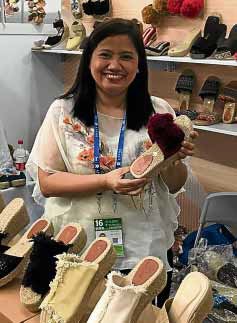NANNING, China — It takes two to tango — or in the case of these Filipino handicraft-makers who have been stealing the spotlight overseas, business thrives in romantic partnerships.
Born in 1996 in the country’s “tsinelas” (flip flops) capital, Liliw town in Laguna province, Jhaz Footwear was the love child of then teenage couple Nephtali and Elvira Moneda.
Jacildo’s Handicraft, on the other hand, was similar to an artwork made piece by piece by Betty and Arnel Jacildo.
Both couples have devoted their lives to preserving their artisanship, be it in domestic or international ventures.
Their commitment and hard work eventually paid off, as Philippine handicrafts crossed cultural bridges to earn their spot in the hearts of foreign consumers.
Standing out
Last week, their work stood out among a sea of products by some 2,800 exhibitors from Southeast Asia, as part of the Philippine delegation to the 16th China-Asean Expo in Nanning, one of the largest trade fairs in the region.
“Having a chance to feature our products abroad makes us feel proud, especially when clients give a thumbs-up to Filipino products,” said Betty Jacildo, 57.
“This kind of business won’t make us rich, but making handicrafts is our first love and we won’t get tired of doing this,” said Betty’s husband Arnel.
In 1982, Betty was working as a sales clerk at Pistang Pilipino, a 1-hectare handicraft shop on Pedro Gil Street in Manila that featured products from local artisans.
That’s where she learned how to make home decorations from indigenous materials.
But in 1995, as Betty recalled, the Philippine Commission for Good Governance padlocked Pistang Pilipino after being linked to the ill-gotten wealth of the Marcoses.
Many artisans whose shops were closed eventually gave up the craft.
But Betty and Arnel, who was then a tailor, had to roll with the punches. They started making their own products, including flower arrangements made from natural-colored shells from Batangas province, Bicol region and Cebu province, and made-to-order functional home decorations.
It was sink or swim back then, said the couple, because the support for local handicrafts dwindled by the late ’90s.
But just as they were building their enterprise sometime in 2003, they lost their Pasay home in a fire, including their handicrafts.
Betty recalled being five months pregnant at the time.
“But we were able to start again by sampling our products in various locations, such as the American Women’s Club of the Philippines in Forbes Park and the Marine Building in Fort Bonifacio,” she said.
Because their products were “uniquely Filipino,” their handicrafts attracted loyal patrons here and abroad.
In just a year, Jacildo’s Handicraft was born.
The business expanded to both local and foreign resellers. They exhibited their products in Italy, Switzerland and in several provinces in China.
What started out small eventually helped support the studies of the six Jacildo children. The eldest child, now 31, has started learning the craft with his father’s guidance.
Love story
The Moneda couple’s business started early in their relationship.
The idea of putting up Jhaz Footwear in 1996, producing mainly espadrilles and sandals, came naturally to Nephtali and Elvira Moneda, who both hail from Liliw town.
Nephtali, then only 16, used his exposure to shoemaking from his mother and grandfather to make ends meet for himself and Elvira.
In every fiesta or bazaar in town, the couple would resell slippers and sandals.
“Whatever amount we got from reselling, we used to set up our own factory and hire workers as we slowly made our own brand,” Nephtali said.
Through the Center for International Trade Expositions and Missions (Citem) of the Department of Trade and Industry, the Jacildo and Moneda couples have been joining the annual China-Asean Expo (Caexpo) in Nanning for 11 and six years, respectively.
“While we do not earn much in exhibiting our products abroad, it helps us analyze their markets and widen our networks,” said Nephtali.
While distributing their products locally still makes up a huge chunk of Jhaz Footwear’s earnings, Nephtali said a common problem in the Philippine footwear industry was the tough competition from other brands, while smaller enterprises that were copying designs from businesses like theirs would sell products at extremely low prices.
Since the Caexpo’s inception in 2004, Citem has been sending local manufacturers to Nanning to feature their products in the 124,000-square-meter exhibition space open to the public.
In 2018, the Philippine delegation, composed of 70 companies and trade officials, was able to book $22 million during the four-day event.
But this year, only 43 companies from the Philippines, including Jacildo’s Handicraft and Jhaz Footwear, joined the country’s commodity pavilion.
The Jacildos and Monedas had to shell out P100,000 each to pay for their booths, hotel accommodations, plane tickets and food.
Unlike other countries in Southeast Asia, Philippine exhibitors are not given subsidies by the government this year.
Still, the two couples said the event provided Filipino artisans the opportunity to gain a share of the Chinese and Southeast Asian markets and make their quality products known worldwide.
“But more than anything, we hope to regain local support for Philippine handicraft,” said Betty.
“Having a one-stop shop for our artisanal products that is accessible to the public could help cultivate the Filipinos’ love for our work,” she added.
